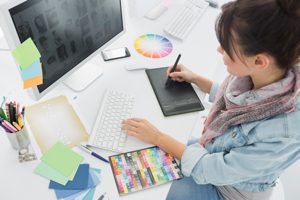
Designing websites and marketing materials can take is a lot of work and planning. This is why we hire experts for the job. A graphic designer’s expertise is to create well-designed logos, promotional materials, and web pages that showcase your company’s personality. When you hire a designer you want to make sure it’s a great working relationship so you get the results you are looking for. In order for that to happen you need to consider these 6 tips:
- Communicate your ideas often. Always be clear about what you are looking for from a designer. Keep the process positive and ask as many questions that you can think of. Keep in mind that this is a problem-solving process. Good design is all about expressing and conveying the right message. Graphic design is not always about what something looks like. It’s also about how a design works and how a design can help people.
- Be very specific and clear about your ideas. Getting to the point by being clear and using direct requests is best. Avoid using buzzwords and jargon like “make it pop” or “that’s sweet.” Clarity is vital. Come with examples of styles, fonts, color palettes or layouts you’d like to use as reference. Instead of saying something looks weird or awful ask if they can simplify certain things that you do not like. Also, ask why they chose certain layouts or colours. Often a little explanation can go a long way. Your designer is not expecting you to be an expert about design; however, it does help if you have a base level of design knowledge and appreciation, so do your research.
- Ask how you can help. Always ask about what information your designer needs from you. The more research materials and samples you can provide the better it is for the designer. Without materials, your designer really can’t create the best designs for you. You know your business best so bring as much information as you can to the table.
- Take time to doodle and make notes. Always make a lot of notes about your ideas. Jot down keywords, websites you love (and why), certain colour choices and fonts. Don’t be afraid to sketch if you have an idea that you find difficult to describe. These sketches do not have to be great drawings – stick figures can still be a direct means of communication. Designers will understand so don’t worry if it’s not artistic looking. Doodling helps to bridge the visual gap between your notes and your ideas.
- Give feedback. Always give feedback early on in the process. One of the biggest frustrations a designer faces is getting to the end of a project and hearing there is an issue they could have corrected many steps ago. Telling designers about issues early saves time and results in a better project – it also saves you money by helping everyone stick to budget. The more honest and open you are at the start of a project will help prevent missed deadlines. This is why there is alway an idea process, a rough stage, and a first draft. The first draft is when you make a list of all the corrections you would like to see have done. Rule of thumb to remember: if you don’t tell your designer something needs to be changed, they won’t know there’s an issue.
- Give your designer some leg room. No one likes to be bothered too much while they are trying to concentrate; nor do we like when someone is hanging over our shoulder while we work. The same rings true with designers. Keep in mind you are not their only client and this is not the only project that they will be working on. If you need to have regular feedback as the projects rolls on, set up times to call or email to discuss their progress. Try setting up deadlines for specific tasks. It’s good to stay in the loop.
Good design is both a working relationship and a creative process for you and the designer. At The GDC Group, we would love to work with you so that you get the results you are looking for. Give us a call today!
